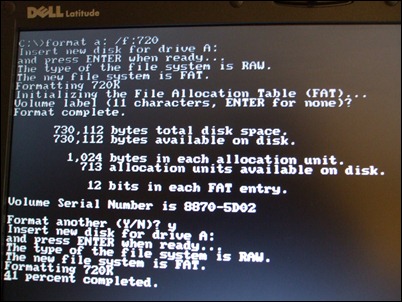Retro Friday: The 720k Floppy Disk
 In the November 1982 issue of InfoWorld, it was announced that Tandon had developed a “tiny” 3½-inch micro-floppy disk drive called the TM35 Microline, providing 875k on two sides of a 3½-inch diskette. The cost was stated to be “in the $200 to $225 range”. Deliveries of the unit happened in the first quarter of 1983.
In the November 1982 issue of InfoWorld, it was announced that Tandon had developed a “tiny” 3½-inch micro-floppy disk drive called the TM35 Microline, providing 875k on two sides of a 3½-inch diskette. The cost was stated to be “in the $200 to $225 range”. Deliveries of the unit happened in the first quarter of 1983.
Side note before continuing: Now you know partially why the Apple Macintosh cost so much with its initial release in 1984, because oh yeah, the 3½-inch floppy drive was a really expensive piece of hardware back then and directly contributed to the unit’s high introductory price.
The 720k is what’s known as a double density diskette, or DD for short. It’s called that because it can encode roughly twice the as many bits per time unit compared to single density. The way it accomplishes this is through a line coding scheme called Modified Frequency Modulation or MFM for short.
720k was not the universal size of the 3½-inch DD floppy. It was marketed as being able to hold a full 1MB, but I don’t believe it could ever achieve that. 720k is what it could do on systems like IBM PC Compatibles and some Atari computers. On Mac it was 400k single-sided or 800k double-sided, depending on generation. On Amiga it was 880k double-sided.
Even though the high density 1.44MB floppy, as in the 3½-inch HD, arrived just four years later in 1987, the 720k DD stuck around for a good long time. In fact it pretty much stayed on the market until floppies altogether fell out of favor with the masses.
Where were DD disks used most?
720k disks were used most in three places.
Some computer systems required them, such as early Macs, Amiga and the Atari ST to name a few.
Many PC games were delivered on 720k disks. Thousands of them. It was a really easy way for game developers to cut costs simply by using diskettes that held less. In fact it was somewhat common for game companies to opt using two DD disks instead of a single HD disk because it was cheaper concerning manufacturing costs.
Non-home-computer devices used DD drives often. One example I can immediately think of are music synthesizer workstations, such as the Ensoniq EPS family of workstations. It has its own proprietary 800k format using DD disks.
Can 720k disks be used in Windows 7 today?
This is best answered question-and-answer style.
Can 720k diskettes be read and written to in Windows 7?
Yes – if the floppy is formatted first in a format Windows can understand.
Can 720k diskettes be formatted in Windows 7?
Since Windows XP, the option to format 720k floppies was eliminated from the GUI – however you can format a 720k disk using the command line with very specific switches.
The command is this: FORMAT A: /T:80 /N:9
This formats 80 tracks with 9 sectors per track, and yes it does work.
Can a 1.44MB floppy be “fooled” into being formatted to 720k in Windows 7?
Yes. Place a piece of tape over the left-side hole, as in the one without the write protect switch on it, then place in the drive and format using the command above and you’ve got yourself a 720k formatted disk:

What possible use could this be to anyone?
For vintage computer enthusiasts, this is useful info.
If you have a really old PC that doesn’t recognize anything but DD disks and you have to get some files copied off that old box, now you have a way.
If you have an Atari ST, formatting a 720k in Win7 as described above can be read on the ST.
If attempting to get exact-copy images from older 720k floppies, having other 720k floppies to do it with sometimes helps out quite a bit.

















One thought on “Retro Friday: The 720k Floppy Disk”